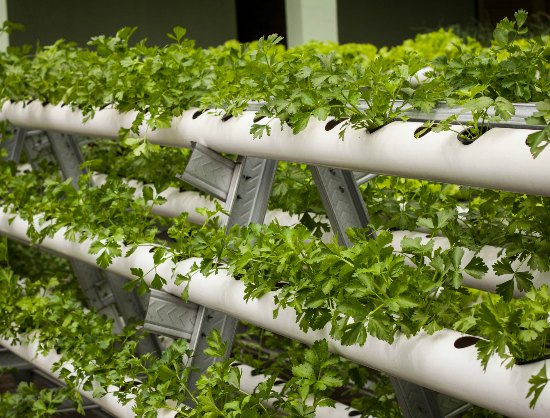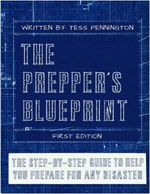This article was originally published by Jeremiah Johnson at Tess Pennington’s ReadyNutrition.com
Tess is the author of The Prepper’s Blueprint: How To Survive ANY Disaster

PVC is actually some pretty versatile stuff. PVC stands for polyvinyl chloride, and it can be found both in rigid or in flexible forms. There are also different uses as per the variance in capabilities.
PVC pipe can have a heat-resistance ranging from about 212 degrees F all the way up to 500 degrees F. Just be on the safe side: take the product number, make, and model, and find out directly from the manufacturer what the temperature range/rating is. PVC can hold up to a pretty good beating from a slew of different chemicals, such as salt, acids, strong bases (alkaline, such as fertilizer), liquid fats, alcohol, and other strong solvents. For this reason, it is used in plumbing for sewage, as well as outflow transport for other noxious wastes and chemicals.
Putting it to use will depend on you researching the types available in your local hardware stores and performing an accurate assessment of them for what you intend. Let’s explore some of those “thinking-outside-the-box” uses for PVC pipe.
- Cache tubes: Yes, PVC pipe (especially the type known as uPVC, or unplasticized PVC) resists solvents and things such as salts and alkaline substances that you find in the soil. You can find some “biggies,” believe me, if you go to a pipe or plumbing warehouse that specializes in large-diameter pipes. You can cache all sorts of things, such as firearms, freeze-dried foods, or anything you wish to hide from the IHM (Incredible Human Mob) that will come “hunter-gathering” through your neighborhood when it hits the fan. Always good to have a surplus stashed away to fall back on, akin to the squirrel and his acorns. Ensure anything that has moving parts is properly coated with oil, grease, etc, and then packed away. There are “pop-on” end caps that you can place on the ends of sections you cut that will stay without needing threading. Here the only thing to limit you is your imagination. As mentioned in earlier caching articles, learn and remember your frost-line. Here in Montana, it’s about 5 feet. Unless you have one that’s about 1-2 feet, you may have to build an “in-ground” passage or aperture to get to your stashed supplies in the wintertime.
- Protective tubing: With end-caps, just as mentioned before. Squirrel away fishing rods, long poles for things such as chimney brushes or tent-frame poles in these guys…strong against impact, weather-resistant, and not too heavy to carry with you.
- For a frame/structure: with “corner-caps,” and “three-way” pieces for where the structure connects, you can make a portable shower point, or even a latrine-shield for yourself out of these, out of (8) 4’ pieces, (4) 6’ pieces, and (8) of those tri-attachments for the corners. Then you can cover/shield the structure with something as simple as some ponchos, small tarps, or (if push came to shove) dark trash bags that you slit open…attach these with either clamps or clothespins. The objective is to make it light and portable.
- Water transport: If you load about a dozen 8 footers (especially the plumbing types that have a sort of “funnel” end that permits them to be attached together), you can make a small sluice to channel water toward your camp…to fill up water cans, or even a small cistern that you can create by digging a “pond-shaped” depression and lining it to prevent water loss.
- Clothes Drying apparatus: can be built of its own using connection pieces, or just simply by lashing a horizontal pipe between a couple of trees. Hey, in “The Day After Doomsday,” your washing machine and dryer are no longer going to be used.
- Greenhouses: This will take some extra planning on your part, but it can be done. You will also need UV resistant rolls of plastic to cover this greenhouse frame. Once again, its main “selling point” will be that you can break down the greenhouse at a moment’s notice and set up shop somewhere else. You could even use it to create an aquaponics system. Use your imagination and experiment with models that can fit your needs. Here are some other ideas for using plastic sheeting.
- Field-Expedient Raft: If you have them thick enough (preferably a big pile of about 3 dozen, with a diameter of about 4 to 6 inches, and (2) end caps for each), you can make a raft by lashing them together after capping the ends. The air inside will make them buoyant. You probably won’t make it that far…but for a short distance, it may be just what you need…to feasibly tow a whole bunch of gear with you…while it’s tethered to your rowboat or kayak. If there’s no rowboat or kayak, it may be what you need to cross a river or small body of water.
- Miscellaneous Uses: Just to have a good supply of it around the house cannot hurt, and it certainly won’t break your bank to buy different sizes a little at a time. This is a visualize and construct type-of-thing. It may be that you just need it to make an emergency repair on some existing plumbing in your home, or to provide some measure of protection or insulation for an outdoor electrical cord, or such.
We’d love to hear any of your suggestions as to what uses you have found to employ PVC pipe. It is inexpensive, sturdy, and can be put to a wide array of uses of which we have just scratched the surface here. Whether you’re a stay-at-home mom who may wish to put a greenhouse together or a would-be Yanomamo blowgun champion, PVC pipe is very versatile stuff that may give you a few things that are more lightweight, portable, and durable than you may have considered with the standard fare at the big-box store. It is all a matter of imagination and inventiveness. Let us know what you’ve done with it in the past. JJ out!
About the Author
Jeremiah Johnson is the Nom de plume of a retired Green Beret of the United States Army Special Forces (Airborne). Mr. Johnson was a Special Forces Medic, EMT and ACLS-certified, with comprehensive training in wilderness survival, rescue, and patient-extraction. He is a Certified Master Herbalist and a graduate of the Global College of Natural Medicine of Santa Ana, CA. A graduate of the U.S. Army’s survival course of SERE school (Survival Evasion Resistance Escape), Mr. Johnson also successfully completed the Montana Master Food Preserver Course for home-canning, smoking, and dehydrating foods.
Mr. Johnson dries and tinctures a wide variety of medicinal herbs taken by wild crafting and cultivation, in addition to preserving and canning his own food. An expert in land navigation, survival, mountaineering, and parachuting as trained by the United States Army, Mr. Johnson is an ardent advocate for preparedness, self-sufficiency, and long-term disaster sustainability for families. He and his wife survived Hurricane Katrina and its aftermath. Cross-trained as a Special Forces Engineer, he is an expert in supply, logistics, transport, and long-term storage of perishable materials, having incorporated many of these techniques plus some unique innovations in his own homestead.
Mr. Johnson brings practical, tested experience firmly rooted in formal education to his writings and to our team. He and his wife live in a cabin in the mountains of Western Montana with their three cats.
Tess Pennington is the author of The Prepper’s Blueprint, a comprehensive guide that uses real-life scenarios to help you prepare for any disaster. Because a crisis rarely stops with a triggering event the aftermath can spiral, having the capacity to cripple our normal ways of life. The well-rounded, multi-layered approach outlined in the Blueprint helps you make sense of a wide array of preparedness concepts through easily digestible action items and supply lists.
Tess is also the author of the highly rated Prepper’s Cookbook, which helps you to create a plan for stocking, organizing and maintaining a proper emergency food supply and includes over 300 recipes for nutritious, delicious, life-saving meals.
Visit her website at ReadyNutrition.com for an extensive compilation of free information on preparedness, homesteading, and healthy living.










0 Comments